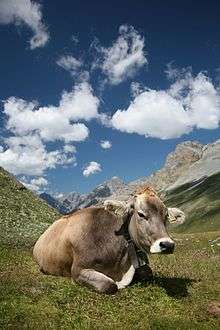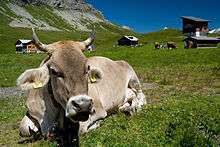Braunvieh
 | |
| Other names | Schwyzer |
|---|---|
| Country of origin | Switzerland |
| Distribution | worldwide |
| Use | dairy |
| Notes | |
| Originally a triple-purpose breed, for milk, meat and draught | |
|
Cattle Bos primigenius | |

Braunvieh (German, "brown cattle") is a breed or group of breeds of domestic cattle originating in Switzerland and distributed throughout the Alpine region. The Braunvieh was originally a triple-purpose breed, used for milk production, for meat and for draught work; the modern Braunvieh is predominantly a beef breed.
History
The Braunvieh derives from the grey-brown mountain cattle raised from mediaeval times in the Swiss canton of Schwyz in Central Switzerland. Documents from the late fourteenth century at the Monastery of Einsiedeln record the export of such cattle to Vorarlberg, now part of Austria.[1]:716 The first known herd book for a cattle breed was that kept at the monastery for the Braunvieh from 1775 to 1782.[1]:718 A description from 1795 of Schwyzer cattle calls them the largest and finest of the country.[2][3]:130[1]:719
Braunvieh were shown at the Exposition Universelle of 1855 in Paris, and at the International Exhibition of 1862 in London.[4]
The Schwyz and two other breeds of Alpine brown cattle were recognised in 1875, and in 1879 the three were combined into a single herd book with the name Schweizerische Braunvieh.[1]:19
In 1897 a breeder's association, the Verbands Schweizerischer Braunviehzucht-Genossenschaften, was founded in Bünzen, in the canton of Aargau.[4]
Between 1967 and 1998 there was substantial cross-breeding with the American Brown Swiss with the aim of improving milk yield, physical size, and udder conformation.[5][6][7]:11 In Germany what began as a programme of improvement became in effect a programme of substitution; by 1994 the genetic contribution of the Brown Swiss to the Braunvieh had reached 60%.[6]
The Original Braunvieh
In Switzerland some breeders had continued to breed the traditional type of dual-purpose Braunvieh, and this was formalised as the Schweizer Original Braunvieh in 1993.[8] It is registered in the same herd book as the modern-type Braunvieh, but has different breeding aims. Efforts to preserve the original Braunvieh type had begun in Germany in 1988 with the formation of the Arbeitsgemeinschaft zur Erhaltung und Züchtung des Original Braunviehs im Allgäu.[6] In Italy it is known as the Bruna Italiana Vecchio Ceppo.[9]
Characteristics
The Braunvieh is a uniform brown or grey-brown in colour; the nose is black and encircled by a pale ring. The horns are pale with dark points. Cows weigh 550–750 kg at a withers height of 138–152 cm; bulls weigh 1000–1300 kg.
Use
The Braunvieh is a dairy breed. Depending on location, milk production ranges between 7,200 (mountain regions) and 12,000 litres per year. The milk has a protein content of 3.5–4.5%.
In other countries
The Braunvieh has given rise to several European cattle breeds in the Alpine region, in Austria, in Germany, in Italy and in Spain, as well as the Brown Swiss in the United States.[1]:19
Austria
The Montafon breed from the southern Vorarlberg is of medium weight, muscular, usually brown with a pale dorsal stripe. Cows weigh 500–600 kg, and bulls 750–1000 kg. It was widespread in 19th century, but became increasingly similar to the Braunvieh through cross-breeding with the Brown Swiss.
Italy
The Bruna Alpina or Bruna Italiana is distributed throughout Italy. Braunvieh were imported from central Switzerland from the sixteenth century, and diffused from the Alpine valleys into the flat country of Lombardy and the Veneto, where they rapidly supplanted the mostly red-coated local breeds, and then further south as far as Calabria.[10]:10 In 1950 it was still the principal dairy breed of Italy, before the Frisona Italiana, the Italian Holstein-Friesian breed, achieved dominance. In Sardinia, Bruna bulls were used to cover local cows, leading to the creation of the tough and productive Sardo-Bruna breed.[10]:10
United States
Braunvieh exported to the United States in about 1870 were bred exclusively for milk production, and developed into the modern American Brown Swiss breed.[7]:11, 15
References
- 1 2 3 4 5 Marleen Felius, Marie-Louise Beerling, David S. Buchanan, Bert Theunissen, Peter A. Koolmees and Johannes A. Lenstra (2014). On the History of Cattle Genetic Resources. Diversity 6 (4): 705–750. doi:10.3390/d6040705
- ↑ Ludwig Wallrath Medicus (1795). Bemerkungen über die Alpen-Wirtschaft auf einer Reise durch die Schweiz (in German). Leipzig: Gräff; cited by Engeler.
- ↑ Willy Engeler (1947). Das schweizerische Braunvieh: Monographie und Quellenwerk über die Braunviehrasse, ihre Verbreitung, Züchtung und Förderung in Geschichte und Gegenwart (in German). Frauenfeld: Huber.
- 1 2 [s.n.] (2012). Geschichte (in German; in English ). Schweizerische Braunvieh. Archived 4 March 2016.
- ↑ Breed data sheet: Braunvieh/Switzerland. Domestic Animal Diversity Information System of the Food and Agriculture Organization of the United Nations. Accessed October 2015.
- 1 2 3 Wolfgang Kustermann (1994). Schwerpunkt - Rinder: Das Original Braunvieh (in German). Gesellschaft zur Erhaltung alter und gefährdeter Haustierrassen. Accessed October 2015.
- 1 2 Sophie Maria Rothammer (2011). Genomweite Detektion von Selektionssignaturen in divergent selektierten Rinderpopulationen mit anschließender Identifikation eines möglichen kausalen Gens (doctoral dissertation, in German). Ludwig-Maximilians-Universität München. Accessed October 2015.
- ↑ [s.n.] (2012). Schweizer Original Braunvieh (in German). Schweizerische Braunvieh. Archived 21 April 2016.
- ↑ Breed data sheet: Bruna Italiana Vecchio Ceppo/Italy. Domestic Animal Diversity Information System of the Food and Agriculture Organization of the United Nations. Accessed October 2015.
- 1 2 Daniele Bigi, Alessio Zanon (2008). Atlante delle razze autoctone: Bovini, equini, ovicaprini, suini allevati in Italia (in Italian). Milan: Edagricole. ISBN 9788850652594. p. 9–11.
-
 Media related to Braunvieh at Wikimedia Commons
Media related to Braunvieh at Wikimedia Commons